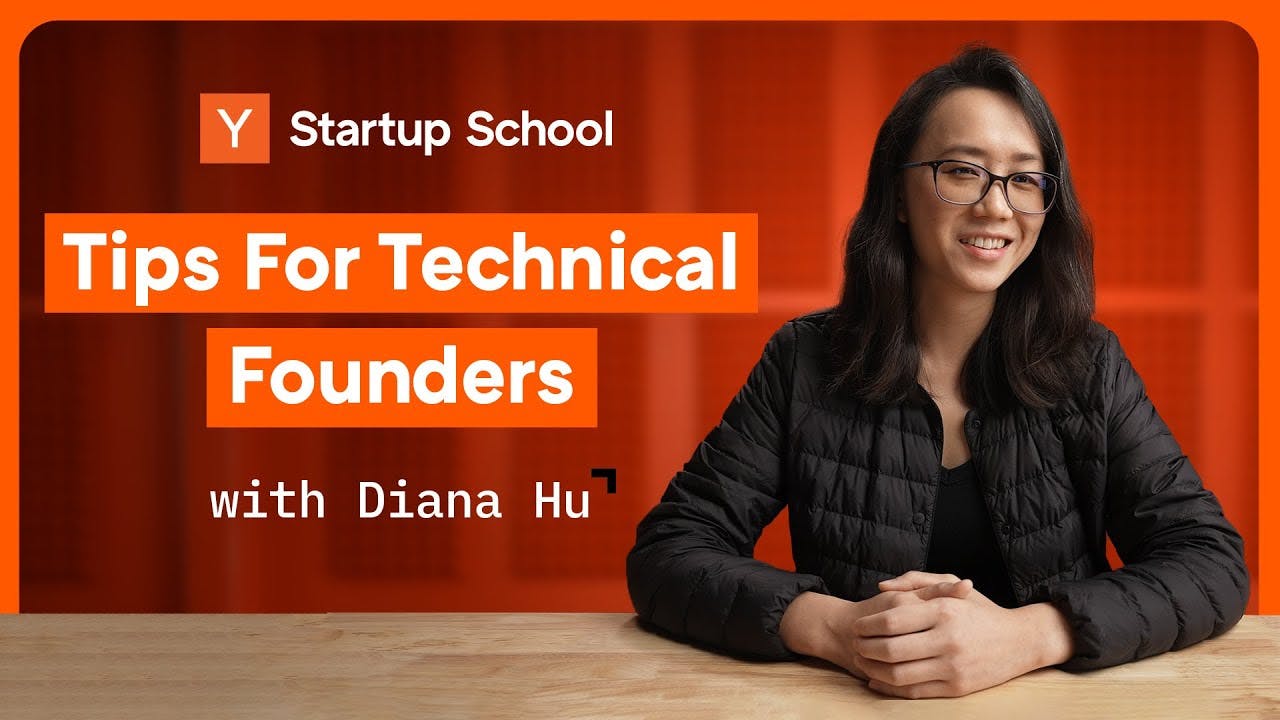Tips For Technical Startup Founders | Startup School
09 Nov 2023 (2 years ago)

Intro (0s)
- No bullet points required for this section as it only contains a greeting and background music.
How to Build and Perpetuate as a Technical Founder (9s)
- Diana discusses her experience from starting as a CTO of augmented reality startup to Director of Engineering at Niantic.
- Presentation on the role of a technical founder and stages of building a startup: ideation, MVP, and launch.
- The talk draws from insights of other YC technical founders.
What Does a Technical Founder Do? (1m56s)
- Technical founders are deeply committed partners in the startup's journey, not just developers.
- They lead product development, interact with users, and make critical technical decisions.
- Early-stage technical founders often handle a wide range of tasks, from coding to IT.
- They focus on building minimum viable technology for the sake of progress rather than perfection.
How To Build (4m38s)
- In the ideating stage, the goal is to quickly develop a prototype to demonstrate to potential users.
- A prototype should be simple and can be created using tools like Figma or Envision for software or 3D renderings for hardware.
- Prototypes like Optimizely's visual editor or Azure Reality's AR algorithms can validate ideas and facilitate user feedback.
- Common prototyping mistakes include overbuilding and delaying user interaction.
Build an MVP: The Startup Process (8m30s)
- The MVP stage requires building a functional product for launch, typically within weeks.
- User commitment, often in the form of payment, is a crucial goal during this stage.
- Hiring too early can be counterproductive; it's essential for founders to stay hands-on to gather insights.
- Examples include Justin TV's founding team building the initial platform by tackling different system elements themselves.
Principles for Building Your MVP (11m29s)
- "Do things that don't scale" principle suggests using hacks like manual onboarding to launch quickly.
- The "9010 solution" emphasizes launching a limited but functional product and avoiding scope creep.
- Simplify the product to limit situations, data types, functionality, user types, or geographic scope.
- Startups have the advantage of moving faster than big companies with this approach.
- Examples of simple MVPs include Doordash's initial static website with Google Docs as a back-end and the strategic focus on a single location.
Choose the Tech Stack That Makes Sense for Your Startup (15m4s)
- Balance your product needs with your personal expertise to ship quickly.
- Keep tech stack simple and choose what allows for fast iteration.
- Utilize third-party frameworks and API tools for functionalities like authentication, payments, and cloud infrastructure.
- Avoid building everything from scratch to save time and resources.
- Cost and scalability concerns of third-party APIs are secondary to moving quickly.
- Tech stack choices are less important if a product gains users—technical scaling issues can be resolved later.
What Happens In The Launch Stage? (19m43s)
- The goal after launching an MVP is to iterate towards product-market fit.
- Use both hard data via a simple analytics dashboard and soft data from user interactions to inform decisions.
- Example of WePay pivoting to an API model after analyzing data and user feedback.
- Continuous iteration is key, illustrated by Segment's frequent launches and feature additions leading to significant company growth.
When You Launch: The Right Way to Build Tech (22m43s)
- Balance fixing bugs, adding new features, and addressing technical debt.
- It is okay to incur technical debt for getting closer to product-market fit.
- Example of Pokémon Go's success despite initial technical challenges.
- Avoid building complex systems like large companies, and focus on insights from users.
- Building tech for growth can come from collaboration between engineers and sales/growth teams.
How the role evolved from ideating to hiring (25m36s)
- After achieving product-market fit, focus shifts to scaling and refining technology.
- The founder's role expands from coding to hiring and setting engineering culture.
- Communication overhead increases with team growth, affecting the amount of time spent coding.
- Founders must choose their role between being a technical architect or focusing on people management.
Summary (26m51s)
- Initially, build a prototype as fast as possible.
- For the MVP stage, build quickly with a non-scalable solution and prioritize iteration speed.
- Upon launch, iterate with data analytics and user feedback while balancing tech development and addressing tech debt.
- The startup's primary objective is to move quickly and adapt.